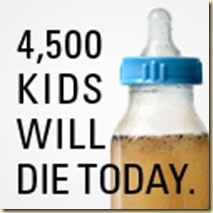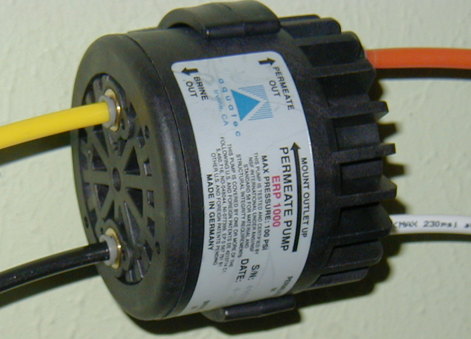September 2010
Go Here if you'd like to read this issue on our website.
An email extension of the Pure Water Gazette.
In this gloomy issue of the Occasional you'll encounter ominous facts and forecasts about the rapidly diminishing quality and quantity of the Earth's freshwater supplies. The sad story of a woman crushed by falling water bottles, plus scary news of a giant reservoir rattlesnake, a killer shrimp, massive fish kills, and weird colored water. You'll hear about horizontal fracking in the Barnett Shale and the unsettling story of the rapid decline of the Earth's groundwater. Find out what kills more people than war and who creates 1/3 of the nation's environmental pollution but almost never gets criticized for it. Then there's nickel, permeate, and brine, plus Pure Water Annie's advice on upgrading your reverse osmosis unit. Cyanotoxins, the effect of forest fires on water, an unhappy insult to the Pasquotank River, and, as always, much, much more. The Occasional is overseen and edited by Pure Water Gazette editor in chief Hardly Waite.
Water News from Around the World

While you were celebrating the arrival of autumn, a lot of important things happened. Follow the links to read all about it.
Nestle Waters is being sued by the family of a woman killed by a pallet of water bottles that fell on her.
Gravitational
Energy Corporation
introduced the Feltenberger Pendulum, a Gravity Assisted Power (GAP)
machine. This unique hand-operated machine uses the force of gravity
to help provide the power needed to operate various types of
machinery, including the drilling of water wells and powering water
treatment equipment.
wells and powering water
treatment equipment.
An eight-foot rattlesnake was captured in a California water treatment plant. (Our Model 77 Countertop Filter removes rattlesnakes easily.)
The International Bottled Water Association has announced its support of Protect Your Groundwater Day, celebrated Sept. 14, 2010. The question is, who is protecting our groundwater from the International Bottled Water Association?
"Water-wise, the world is in a state of crisis. More people die and suffer from the lack of access to safe drinking water and to basic sanitation, than from war." U.N. Water and The United Nations Secretary-General's Advisory Board on Water and Sanitation. Report. |
A killer shrimp, dikerogammarus villosus, which kills its prey and leaves it uneaten, has been found for the first time in British waters.
US Dept. Of the Interior has concluded that "If the Water Looks and
Smells Bad, It May Be Toxic."
The statement applies especially to
cyanotoxins
Read more about scantlings on the Occasional's website.
Massive fish kills have been reported in Louisiana waterways.
In Elizabeth City, VA a 30-inch sewer pipe broke, dumping 500,000 gallons of sewage into the Pasquotank River.
The Marine Corps. worked hard to hide its own culpability but did little to help marines who were sickened by Camp Lejeune's contaminated water.
Ten Central Texas cities have elevated arsenic levels in their drinking water.
Ocean City, MS residents have had
"brown, yellow and green water " since Hurricane Katrina
and are refusing to pay their water bills.
A study recently completed by a team of Canadian researchers indicated that high concentrations of manganese in drinking water may have an adverse effect on children’s intellectual abilities.
Wildfires not only threaten forests, they also affect water quality.
The DEA (Drug Enforcement Administration) now discourages flushing unused prescription drugs, considering it a threat to public health. Calling prescription drug abuse "the nation's fastest growing drug problem," the agency encourages citizens to take advantage of "take back events" that it is sponsoring to dispose safely of prescription drugs.
Controversial phosphorus reduction
rules have been approved by state agencies in Wisconsin in spite of
widespread whining by agricultural and industrial polluters.
(Phosphorus, mainly from manure and fertilizer, encourages algae
blooms in streams and lakes which choke out other life.)
A high-level conference in Stockholm issued a statement that “Lack of water and sanitation makes people poor. Inadequate access to water and sanitation deprives billions of people, especially women and girls, of opportunities, dignity, safety and well being.”
The city of Tulsa, OK announced that it is switching to disinfection of its water with chloramine. (The Tulsa World article includes a good explanation of chloramine and the reason that cities prefer it to chlorine.)
It is estimated that 50 percent of the children in
the developing world attend schools that have unsafe water—if they
have water at all.
 An estimated 4,500 children die each day as a result of water-related
diseases. “Solving this problem would be a greater accomplishment
than the building of the Great Wall of China, the Apollo 11 moon landing, or the construction of the Great Pyramid,” said David
Trouba of the Water Supply and Sanitation Collaborative Council, a
key participant in World Water Week. It should be noted that this "Water
Week" celebration in Sweden, held in mid-Sept of this year, is one
of the world's largest. (There are a number of other
Water Weeks
celebrated.
Apparently, anyone who wants can declare a world water
week.
We're thinking of doing it ourselves.)
An estimated 4,500 children die each day as a result of water-related
diseases. “Solving this problem would be a greater accomplishment
than the building of the Great Wall of China, the Apollo 11 moon landing, or the construction of the Great Pyramid,” said David
Trouba of the Water Supply and Sanitation Collaborative Council, a
key participant in World Water Week. It should be noted that this "Water
Week" celebration in Sweden, held in mid-Sept of this year, is one
of the world's largest. (There are a number of other
Water Weeks
celebrated.
Apparently, anyone who wants can declare a world water
week.
We're thinking of doing it ourselves.)
“Charting New Waters: A Call to Action to Address U.S. Freshwater Challenges,” is the culmination of an intensive two-year collaboration exploring solutions to U.S. freshwater challenges.It was presented to the Obama Administration at a meeting of federal agencies convened by the White House Council on Environmental Quality (CEQ) on Sept. 15, 2010. The report was prepared by "a diverse coalition of businesses, farmers, environmental not-for-profits and government agencies."
Here are some highlights:
“There was broad consensus among participants that our current path will, unless changed, lead us to a national freshwater crisis in the foreseeable future. . . This reality encompasses a wide array of challenges … that collectively amount to a tenuous trajectory for the future of the nation’s freshwater resources.”
"For too long, our society has treated water as a cheap, non-strategic and infinitely available resource. Not anymore. Threats to water quality and access are putting our businesses, communities and way of life in jeopardy. The time to act is now."
Water Fact: On average, Americans use 79.6 billion gallons of groundwater per day, according to National Ground Water Association. That’s the equivalent of every man, woman and child in our country each consuming 2,923 12-ounce glasses of water every day. Agricultural irrigation is far and away the largest user of groundwater in America, consuming 53.5 billion gallons of groundwater every day. |
Getting A Perspective on Water Use
by Gene Franks
The Sept. 23, 2010 issue of our local newspaper, the Denton Record Chronicle, reported on a local meeting held to promote regulation of groundwater use in our county. One participant, a Mr. Klement, who witnessed water wells going dry in his area because of excessive drawdown of groundwater by gas drillers making "horizontal fractures" in the Barnett Shale to expedite the harvest of natural gas, spoke with considerable knowledge of the subject:
“Guys like me don’t have a city to assist us trying to be a spokesman for individual landowners,” Klement told the crowd, explaining the need for the district.
He said the area needs a conservation district to get a handle on the usage by Barnett Shale drillers.
The average horizontal fracture can use anywhere from 1 million to 7 million gallons of freshwater. There are currently about 14,000 wells in the 24-county Barnett Shale, with another 3,300 permits to drill granted by the Texas Railroad Commission.
Those 3,300 permits mean shale drillers must find as much as another 23 billion gallons of water in the coming months.
“The longer we wait, the longer we don’t have the tools,” Klement told the crowd.
“Out where I am, they [gas drillers] build 15-acre lakes fed by wells 24 hours a day. When they’re fracking, they have four to eight wells going at a time. You can’t believe what’s going on out there. We’re already six months too late — this is the reason for trying to get this set.”
I would like you to think about the wells pumping around the clock to fill the 15-acre lakes that will supply the 1 to 7 million gallons of freshwater used to frack each of the wells that Mr. Klement described the next time you read in a "Seven Ways to Save the Planet" article that you're a bad person if you fail to turn off the water while you're brushing your teeth.
As important as it is to avoid waste, the way we brush our teeth really isn't the decisive factor when it comes to saving the planet. The low-water tooth brushing campaign is one of the many feel-good practices that divert our attention from the real issues. We're led to believe that if we'll just fix our drippy faucet, get some low-water appliances, recycle our aluminum cans, and not over-water our lawn everything will be alright.
The real issue with water is that we are allowing industrial and agricultural megacorporations to obtain for a pittance what is really a public treasure. We're fretting about shorter showers and more water-frugal ways to wash our hands while golf courses and the lawns and the gas wells of the wealthy are being flooded with cheap water.
Americans are easily managed by distraction.
We have also been taught to be very concerned about our choice of bags at the grocery store. However, whether you choose plastic or paper or bring in your own special reusable bag with rain forest pictures and slogans printed on it, your choice of grocery bags amounts to only a tiny sliver of the environmental impact of the grocery purchasing process. Corporate food producers love for you to focus on the grocery bag because it keeps your mind off of the massive environmental devastation that results from our current system of producing and delivering food. It is a system designed to make money--not to provide good food or to protect natural resources. The benefit of a year's worth of virtuous plastic bag refusals is tiny compared to the impact of the food you choose.
Not long ago when I was helping a customer plan a water treatment system for his lawn watering well I came to the realization that each day he uses more water by 11:00 AM to keep his spacious lawn green than I use in my entire home for a whole month. And I don't even try to save water. I selfishly shower as long as I want.
It should come as no surprise that we are taking water out of the ground much faster than natural methods can replace it. Here is a UPI release that appeared this month.
Groundwater depletion rate said doubled
Published: Sept. 23, 2010
Findings published in the journal Geophysical Research Letters say water is rapidly being pulled from fast-shrinking subterranean reservoirs essential to daily life and agriculture in many regions.
So much water is being drawn from below ground that its evaporation and eventual precipitation accounts for about 25 percent of the annual sea level rise across the planet, the researchers said.
Global groundwater depletion threatens potential disaster for an increasingly globalized agricultural system, Marc Bierkens of Utrecht University in Utrecht, the Netherlands, said.
"If you let the population grow by extending the irrigated areas using groundwater that is not being recharged, then you will run into a wall at a certain point in time, and you will have hunger and social unrest to go with it," Bierkens says. "That is something that you can see coming for miles."
The researchers say the rate at which global groundwater stocks are shrinking has more than doubled between 1960 and 2000, increasing the amount lost from 30 cubic miles to 68 cubic miles per year.
Because the total amount of the world's groundwater is unknown it's hard to estimate how fast the global supply would vanish at this rate, but if water was drained as rapidly from the Great Lakes they would go bone-dry in around 80 years, scientists say.
Most of us are vaguely aware that war devastates the environment abroad. The Vietnamese Red Cross counts 150,000 children whose birth defects were caused by their parents' exposure to Agent Orange. Cancer rates in Iraq are soaring as a result of depleted uranium left from the Gulf War. But what about closer to home? Today the U.S. military generates over one-third of our nation's toxic waste, which it disposes of very poorly. The military is one of the most widespread violators of environmental laws. People made ill by this toxic waste are, in effect, victims of war. But they are rarely acknowledged as such. Sunaura and Astra Taylor. Read their full article on the Pure Water Gazette's Website. |
A true water saving device: The Simple Permeate Pump
One of the most effective water savers known is the simple device known as the permeate pump. This simple apparatus, which requires no power and produces no waste, when added to an existing reverse osmosis unit, can cut its water use in half.
Unlike electric pumps that boost inlet pressure to reverse osmosis units, the unique "permeate pump" enhances performance without actually providing additional pressure for the inlet side of the unit. The permeate pump, instead, greatly reduces the back pressure from the RO unit's storage tank. This allows the RO membrane to take full advantage of the pressure that it has.
Permeate is water treatment jargon for the product water of the reverse osmosis unit--water that has been treated by the membrane, the water you're going to drink. Brine is the rinse water, the water that is carrying away the impurities rejected by the membrane, the water that will ultimately go down the drain.
The pump works by storing the hydro power of the brine, the reject water, and using the energy to power the permeate under pressure into the unit's storage tank.
RO storage tanks in undersink units use air pressure to push water out the faucet. With standard RO units, the unit must force the water into the storage tank. This robs it of pressure and thus efficiency. With permeate pump units, the pressure from the reject water is used to overcome this back pressure from the tank and to power the permeate into the storage tank.
The result is a quite remarkable increase in unit efficiency. Since the RO unit can fill the tank much faster without the hindrance of back pressure, far less reject water is used and the permeate, or product water, is often purer.
We've tested the permeate pump before under a variety of conditions, but we recently did the most informal test possible just to see how much drain drain water was really saved by use of the pump.
Using our office RO unit, a several-year-old Black and White unit with a 24 GPD Filmtec membrane that's three years or so old, we tested the permeate vs. brine output under everyday working conditions. The unit has an an undersized storage tank (about one gallon total capacity at 40 psi). To test the unit, we simply drew a quart of water out of a full tank and let the RO unit refill the tank, capturing the drain water in a bucket.
The conditions: Inlet Pressure about 80 psi (straight from the pipe--we have good water pressure). Temperature (a warm Sept. day, but we didn't measure the water temperature). FYI: Water temperature affects RO output considerably--the warmer the water, the faster the unit produces water. Configuration: The unit has our regular Payne hydraulic shutoff system with a standard Aquatec permeate pump installed. Tank pressure full: just short of 59 psi. With or without the pump, the Payne shutoff turns the unit off at 59 psi with the 80 psi inlet pressure. Inlet TDS: 173. (Product TDS was around 11, with or without the pump.)
We did two trials with the permeate pump, then removed the pump and did two trials without the pump.
Average brine produced to refill exactly one quart of water drawn from the storage tank:
With the pump: 2.1 quarts.
Without the pump: 4.1 quarts.
The pump's performance was great. We were also surprised that the standard Black and White unit performed so well in spite of the back pressure from the storage tank.

How to Add a Permeate Pump to your Current RO Unit
by Pure Water Annie
First, you need to know what permeate
means.
It's the product water of the RO unit, the water you're going
to drink.
You also need to know what brine means.
It's the reject
water—the water that goes to the drain pipe.
Do not let Annie hear
you call it "waste" water, as the ignorant sometimes do. It
isn't "waste."
This water performs the important function
of carrying away impurities and keeping things clean.
That's what
your dishwater does.
You don't call dishwater "waste water,"
do you? Isn't it as important to have clean drinking water as clean dishes?
On the end of your membrane housing
that has two tubes coming out, the permeate is the one nearest the
middle and the brine is the one that's set off to the side.
The
permeate tube goes to your auto shutoff valve and the brine tube goes
to your drain pipe.
To add a permeate pump to a unit without removing the auto shutoff valve(which is what we recommend if you have good inlet water pressure), reroute the permeate line so that it goes from the membrane to the "Permeate In" port of the pump. Then connect the "Permeate Out" of the pump back to the port of the shutoff valve that you removed the original permeate tube from. This is one of the "tank" ports on the shutoff valve. If there's a check valve inserted in the permeate line, it goes before the Permeate In.
The brine side is even easier. The brine goes from the membrane housing to the "Brine In" of the pump and from the "Brine Out" to the drain pipe. If there's a flow restrictor in the line, be sure it goes before the pump.
To add a permeate pump to an RO unit from which you're removing the shutoff valve (which is what we recommend if you have low inlet pressure), start by taking the shutoff valve completely off of the unit. Then, connect the tube that used to go into the "In" of the shutoff valve directly into the In port of the RO membrane. (That's the port on the end of the housing that has only one port.) Then, referring to the picture above, complete the installation as follows:
Attach the permeate tube leaving the membrane to the Permeate In of the pump. (The check valve, if any, must go before the pump.)
Connect the Permeate Out of the pump to the tee that sends water to the post filter and the storage tank.
Direct the brine from the RO unit directly into the Brine In of the pump. (The flow restrictor goes before the Brine In.)
Connect the Brine Out of the pump to
the drain line.
When you start the unit up after the retrofit, it will make a thumping sound when it runs. If it thumps, you got it right. If it doesn't thump, look for the problem. You can call Annie for advice is you promise not to talk about waste water.
New on the Occasional's Website: Pure Water Annie's Glossary of Water Treatment Terms. Everything from Absolute to Zebra.
Water Contaminant of the Month: Nickel
Nickel is a silvery white metal. It is found in most water, usually at the level of about one part per billion. Although it is a suspected carcinogen when inhaled, there is no evidence that it poses a threat when ingested orally. In some it produces allergic reactions.
The EPA has no proposed MCL for nickel.
Removal from water can be done by a strong acid cation exchanger. Activated carbon reduces nickel, and reverse osmosis removes 97% to 98%.

Pure Water Gazette numerical wizard B. Bea Sharper on World Water Conditions.
Gallons of water used to perform a "horizontal fracture" on a single natural gas well: one to seven million.
Percentage of children in the developing world that attend schools with unsafe water: 50%.
Estimated number of children who die each day as a result of water-related diseases: 4500.
Fraction of the nation's toxic waste generated (and poorly disposed of) by the US military: 1/3.
Gallons of groundwater used each day by Americans: 79.6 billion gallons.
Gallons of this total that are used for agricultural irrigation: 53.5 billion gallons.
Number of people exposed to Camp Lejeune's fuel-contaminated water before its wells were finally closed: 1,000,000.
Number of lakes in Wisconsin that are said to be "impaired" by excessive phosphorous: 172.
Amount of water used by the average tooth brusher who runs the water full blast while brushing: 3 gallons.
Gallons of water used every day by a single golf course in Tampa, Florida: 178,800 .
Go here for More B. B. Sharper.


